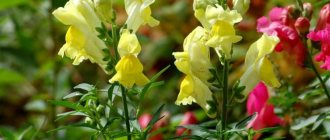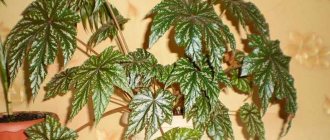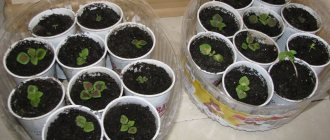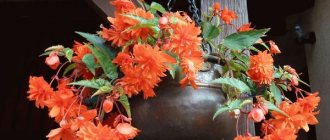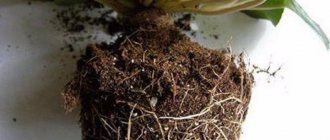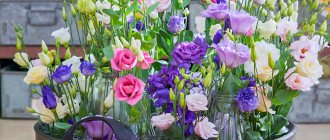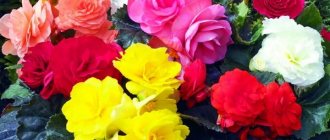Begonia is a perennial flowering plant. Flowers are simple, double, semi-double, of various colors and shades. It blooms from June until frost; in indoor conditions, the flowering period lasts up to 8 months. Does not tolerate negative temperatures.
The ampelous varieties of this plant differ from the usual ones in the direction of growth. The stems grow horizontally and hang down under their own weight in flowerpots or pots. The ampelous characteristics are most pronounced in tuberous and Bolivian begonias; other varieties most often have a bush-like form.
Among flower growers, the most popular series of hanging begonias is “Chanson”. The flowers of plants in this series are double, large, numerous, and of various colors. There are pink, white, yellow, bright red. Two-color begonias look very impressive - pink-white and orange-yellow.
The foliage is highly decorative. The carved, often asymmetrical leaves can be green, burgundy, pink or have several shades.
From planting to flowering it takes from 4 to 6 months, depending on the varietal characteristics and maintenance conditions. In the second year of development, flowering occurs in late February or early March.
Sowing begonia seeds
Growing ampelous begonia from seeds does not involve much difficulty. Unlike many other flowers, ampelous begonia tolerates planting well in the early stages. For full development, 10 hours of lighting per day is enough for her. Therefore, most often sowing begins at the end of January or beginning of February. If it is not possible to provide additional light to the seedlings in the early stages of development, it is advisable to sow later, from mid-February to early March.
Before sowing, you need to prepare: a greenhouse, seeds, soil, and a spray bottle.
Any container covered with transparent material can be used as a greenhouse. It is important to ensure good drainage; waterlogging is dangerous for seedlings.
You need to be careful when choosing seeds. They lose their viability very quickly, especially if stored at room temperature. Therefore, fresh ones are needed for sowing, preferably from last year’s harvest. The seeds are very small and are most often sold coated.
For sowing, light soil, neutral or slightly acidic, is required. Ready-made soil mixtures can be used labeled “For citrus fruits” or “For azaleas.” Also, seeds develop well in coconut or peat tablets.
In order to make a soil mixture yourself, you need the following ingredients, taken in equal parts: garden soil, humus, peat, sand. All components are thoroughly mixed, crushed or large fractions are removed, and sterilized. You can add perlite to the mixture, in which case the amount of sand is reduced by half.
It is undesirable to add ash and manure as fertilizers, even well-rotted ones. Begonia seedlings do not require large amounts of nutrients; excess nitrogen contained in manure increases the risk of fungal diseases. Ash reduces soil acidity, slowing down the development of begonias.
Drainage is laid out in the growing container, and the soil mixture is poured on top in a layer of up to 3 cm. It is necessary to leave 2 - 3 cm of free space in the container for the development of seedlings. The soil surface should be uniform, without cracks or bumps.
The seeds are placed at a distance of 1 cm, without falling asleep. Uncoated ones are simply scattered over the surface. After this, the seeds are sprayed with a spray bottle, covered, and put in a warm place. Begonia requires a temperature of 18 to 25 °C for germination.
Sowing in peat or coconut tablets has some peculiarities. There are many crevices in the fibrous structure of the tablets, so the seeds can be washed inside. In this case, they will not be able to germinate. It is advisable to add a little fine soil or sand to the surface of the tablet before sowing the hanging begonia, moisten it and level it.
Description and varieties
As a rule, hanging begonia is grown in hanging pots and flowerpots. It decorates terraces, gazebos, arches. Plants that grow outside require careful care, unlike indoor flowers.
Ampelous begonia has tuberous roots, stems 20-60 centimeters long, large leaves 10-15 centimeters long.
The plant blooms with unisexual, innumerable, large simple or double flowers. First of all, on a double begonia you can see opened simple flowers; after a while, double flowers begin to bloom.
The most popular varieties
These varieties are the most common:
- Bolivian ampelous begonia is a modification, the characteristic feature of which is that the offspring shoot upward, but when their length reaches 30 centimeters, they attractively fall down, creating a multi-tiered flower cascade;
- Begonia Santa Cruz - breeding it does not cause much trouble for the agronomist. The formation is rapid. The plant is spreading, forms countless shoots, the average length of which is 40 centimeters. The inflorescences are red-orange and fuchsia.
- Begonia Belleconia Chardonnay is a creeping, undemanding crop; during flowering, countless bright red flowers are formed; they are characterized by a bell-shaped shape;
- Begonia Chardonnay - the variety is distinguished by its spreading nature, shoots up to 50 centimeters long are formed. Blooms from mid-summer until the first cold weather. The inflorescences are white, red, pinkish and orange.
- Begonia Pink fung is a bushy tuberous plant, the height is no more than 20 centimeters. During flowering, a huge number of pink inflorescences are formed. When following agrotechnical rules, it blooms magnificently and for a long time. The main feature of this variety is its unpretentiousness in breeding.
- Begonia Illumination is a massive plant, the length of its shoots can reach up to 0.8 meters. The flowers are formed large, their diameter can vary from 8 to 12 centimeters. An adult crop can cover up to 1 meter of area in diameter. Grows readily in shade and partial shade.
Seedling care
The first shoots will appear 2 - 3 weeks after sowing. Old seeds may take longer to germinate, up to a month. The seedlings are very small and often not visible to the naked eye.
Development is very slow; it can take more than a month before the first true leaves appear. At this time, begonia is very vulnerable; it is necessary to carefully monitor the soil temperature and humidity.
Begonia develops best at temperatures from 15 to 22 °C. If the soil is colder, fungal diseases such as blackleg may appear. It is not difficult to notice the first signs of the disease; plants stop growing and quickly wither. In this case, it is urgent to treat with fungicides and replant the plants in clean soil. At higher temperatures, begonia may stretch. In addition, the soil dries out faster, making it more difficult to maintain the necessary moisture.
Water the shoots of hanging begonia from a spray bottle or pointwise from a syringe with a needle at the root. The spray bottle is set to the finest spray; large drops can break the stem. The film with which the greenhouse was covered is not removed until real leaves appear on the seedlings. Sometimes mold may appear on the surface of the soil, in which case the seedlings are sprayed with a pink solution of potassium permanganate. Most often, it does not interfere with the development of plants; after the cover is removed, the mold disappears completely.
After the true leaves appear, the begonia begins to harden off. Plants are left without shelter for half an hour, increasing the ventilation time by an hour every day. After 2 weeks, you can leave the flowers open overnight.
If necessary, the ampelous begonia is picked. The soil used is the same as for germination. You can plant plants in separate containers, for example, cassettes, or in a common one. The volume of individual containers is from 0.2 to 0.5 ml. The total size depends on the number of plants planted, the distance between them should be at least 3 cm, the height of the soil layer should be at least 5 cm. Plants sown in tablets do not need picking.
Grown plants are planted in pots or flowerpots on a leg. If the plants will be indoors, the timing of transplantation does not matter. Begonia is planted in flowerpots that are located outside after the soil has warmed up to 15 °C, having previously prepared a shelter in case of frost.
Planting ampelous begonia in the ground
Ampelous begonia is rarely grown in open ground. Most often it is used to decorate the borders of high flower beds or as a tapeworm on an alpine hill.
Most garden plants prefer alkaline soil, developing poorly in acidic soil. Begonia prefers slightly acidic soil, so neighbors in a common flower bed must be selected with the same requirements, or a separate fenced-off cell must be made for begonia.
Begonia can be planted after the soil at a depth of 10 cm has warmed to 15 °C. If the plant grew indoors, it must be prepared for contact with direct sunlight. To do this, it is taken out into the open air for several days, leaving it in partial shade. If this is not possible, the plantings are shaded with thin white fabric, fine mesh or white agrofibre. In cloudy weather, the shelter can be removed.
Caring for adult hanging begonia is simple - timely watering and fertilizing if necessary. For the winter, two-thirds of the begonia's leaves are removed, treated with fungicides and placed in a cool place with a temperature of 2 to 5 degrees Celsius. Lighting during the dormant period is not necessary.
The delicate beauty of ampelous begonia will not leave anyone indifferent; the ease of caring for an adult plant compensates for the difficulties of growing from seeds.
Secrets of growing ampelous begonia from seeds
Lately, ampelous begonia has become very popular. Depending on the species, the plant can be either annual or perennial. It combines harmony, attractiveness, temptation, tenderness, brightness. It has asymmetrical petals, a beautiful bush, and luxurious flowering. But its biggest advantage is its unpretentiousness. What could be better when you can enjoy beauty and at the same time make a minimum of effort. And in order to grow such a flower from seeds yourself, you need to know all the secrets of its cultivation. And then it will delight you and your loved ones with its rich and magnificent flowering.
Planting hanging begonias in the garden
Latest articles about gardening
Pickling cabbage in February 2022 according to the lunar calendar
How to treat pepper seeds with hydrogen peroxide before planting seedlings?
Treating pepper seeds with potassium permanganate before planting seedlings
If the seedlings are intended for planting in the garden, then in early May they are moved to the greenhouse. On warm sunny days, young begonia plants are opened, and at the end of the month the cover is removed to harden the seedlings. A week before planting, seedlings are fed with potassium phosphate at the rate of 5 g per 10 liters of water. It is necessary to plant grown flowers in the ground when the threat of lower temperatures has passed. All that remains is to water, weed, loosen and enjoy the beautiful and abundant flowering.
Begonia is an incredibly beautiful plant and deserves to be grown from seeds - the process is very long, but interesting. Growing begonia from seeds is less common than from tubers or cuttings, but the results with this method of planting a flower are no worse. Be sure to take into account the plant’s love for the sun, its intolerance to alkalized soils, as well as the need for watering only during the flowering period, and any of the types or varieties of begonia will grow freely in your apartment or on your summer cottage.
Features of the plant
Begonia has many species, currently there are more than 1000 of them. This flower can often be found in South America, India, Asia, on the island of Sri Lanka, and in Africa. It blooms continuously from spring to late autumn. Begonia loves light very much, it needs regular watering and a little feeding.
In ampelous begonia, flowers appear at the level of 5 or 6 nodes. In the leaf axil there are male and female flower stalks, the diameter of which is up to 8 cm. Each bud blooms on average for 10 days, then falls off and is immediately replaced by other flowers.
Most often, this flower grows in a hanging basket or in a pot with a long stem. It is best to keep it on the south side, where the sun shines constantly. On very hot days, it is recommended to move the begonia to the east side, so you will have green leaves on the plant and it will not turn yellow.
Begonia looks beautiful in summer cottages when it decorates verandas, gazebos or just a balcony in large quantities. Many novice gardeners do not dare to buy ampelous begonia seeds and buy ready-made flowers. But how nice it will be to grow such a magnificent creature from one seed. And all the tips below can work this miracle.
Reproduction
You can propagate ampelous begonia in the following ways:
- seeds,
- stem cuttings,
- dividing tubers.
Begonia propagates quickly and easily from stem cuttings, retaining all the characteristics of the variety. The main characteristics of the mother plant are also well preserved when dividing the tubers. To do this, take large old tubers with more than seven buds and cut them from top to bottom into several segments with a very sharp knife. There should be at least two buds on each piece. The sections are dried and the resulting tubers are planted in the usual way.
Ampelous begonia from seeds also turns out strong and healthy. Sowing and caring for sprouts is the same as for other plants with very small seeds.
Ampelous begonias are used both for decorating rooms and for landscaping balconies, windows, and terraces. There are many varieties of such plants, distinguished by their diversity, beauty, and long flowering. In addition, most modern varieties are resistant to rain on flowers.
There is a whole series of varieties of hanging begonia - “Chanson”. These are excellent plants with semi-double and double flowers with a diameter of 6-8 cm. The shape of the flowers resembles a camellia. The length of the shoots of begonias in this series is from 30 to 40 cm.
The most common varieties of the Chanson series:
- E051 (White F1),
- E052 (Yellow F1),
- E053 (Salmon F1),
- E762 (Pink F1),
- E054 (Copper F1),
- E055 (Bright red F1),
- E056 (Dark Red F1),
- E058 (Vanilla yellow F1),
- E606 (Two-color Pink and white F1),
- E607 (Two-color Orange-yellow F1).
Soil and seed preparation
Before you start sowing, you need to prepare the soil and seeds in advance. Let's start with the seeds. They need to be prepared several weeks before sowing. Begonia is usually planted in late February or early March. There are a lot of seeds in the bag and you need to be careful with them. It is advisable to mix them with sand before planting. But most often they are sold in the form of granules and this makes sowing much easier.
As for the container and soil where you need to plant begonia seeds, here you need to buy a special box and a peat tablet. You can also buy soil at the store or prepare it yourself. For this you will need:
- one part peat;
- one part sand;
- two parts of leafy soil.
All this is mixed and poured into a container where the begonia will continue to grow. It is very easy to grow begonia from seeds and you do not need to buy ready-made seedlings.
When everything is ready for planting, you first need to pour drainage into the container. This is done so as not to over-moisten the soil. Because in such a case, decay may occur. For drainage, you can choose small pebbles, pebbles or glass beads. Now you can lay out the soil you made. Then use a spray bottle to lightly moisten it. The soil should be moist, not wet.
Now you can spread the seeds over the entire surface and lightly press them to the ground, but there is no need to immerse the seeds inside. There is no need to put anything on top. If you use a peat tablet, then you need to make sure that the soil does not dry out. Cover the top with glass or cling film and place on the windowsill, on the south side.
The temperature in the room should be from 20 to 27 degrees Celsius. It is necessary to wet the soil using a spray bottle or through a tray, since a direct stream can wash away the seeds. The first shoots can be seen after nine days.
Propagation by seeds
To get a lush flowering plant, you need to know how to grow begonia from seeds
. This process begins in early spring. First you need to prepare the soil and purchase seeds. Seeds can be of two types:
- granular - considered more convenient for planting due to its size and nutritious coating;
- ordinary ones are small in size and do not have a nutrient shell; they are best planted in containers intended for seedlings.
Sowing seeds
If granulated seeds are taken for sowing, you can use peat tablets as soil, which allows you to avoid picking. The tablets must be soaked in water in advance, then placed in a tray, and begonia seeds placed on top of each. You need to monitor the temperature, it should not be below room temperature. It is better to moisten peat tablets using a spray bottle; they should not be allowed to dry out, otherwise the young shoots may die.
How to care for hanging begonia seedlings photo
To provide lighting for 12 hours a day, you need to use fluorescent lamps, then the seedlings will grow and develop. Artificial lighting is gradually reduced depending on the length of the day. Seedlings must be gradually hardened by opening the film for 15-20 minutes a day, so the sprouts will get used to the external environment and develop immunity.
How to pick seedlings
If granulated seeds and peat tablets were used for sowing, then picking the seedlings is not necessary. The shoots are transplanted into separate pots with planting peat and covered with the main substrate. The seedling can be watered a little and placed in a lighted place.
If ordinary seeds were sown, then 1.5 months after germination the seedlings must be pricked. To provide the plant with a decorative appearance, it is better to plant ampelous begonia in hanging pots of 4-5 shoots. Over time, the stems will stretch and begin to curl downward, providing an ampelous appearance.
Grow begonia from seeds
It’s not difficult, it’s enough to know the algorithm of actions and follow their sequence. A growth stimulator is not used when transplanting seedlings, but after a month they begin to feed the plant with complex fertilizer. To improve flowering, it is better to use phosphorus-potassium fertilizer. Begonia blooms longer indoors than outdoors; this must be taken into account when placing it.
Landing in the ground
Begonias are planted in the ground at the end of May, when the weather is more or less stable and frosts are not predicted. If you are in the northern region, you can wait until the beginning of June. It is advisable to check the weather for a week in advance in order to have time to take care of the plant. If it rains, you can cover the seedlings with polyethylene or lutrasil.
You need to plant it immediately in a prepared hole, which is filled with a special soil composition. For the first three weeks, it is necessary to constantly feed the plant.
There is no need to worry that the begonia will stop growing. Even in extreme heat this can be avoided. It is enough to increase the volume of liquid for irrigation.
Growing ampelous begonia from seeds at home
In modern apartments, housewives grow a huge variety of flowers. Ampelous begonia occupies a special place in this process.
It is better to propagate this flower by seeds. Even tuberous begonias are best propagated by seeds. Growing ampelous begonia from seeds at home is most preferable for several reasons. Firstly, it is more economical, since seeds are much cheaper than tubers, and secondly, storing seeds is much easier. Although this process will take much longer, this does not frighten avid gardeners.
Begonias are quite attractive to look at, regardless of whether they are foliage or floral. Particular attention should be paid to hanging begonia, since it can decorate not only a room, but also a balcony and terrace. This indoor plant is quite unpretentious, but at the same time it always looks festive and beautiful.
Description
Ampelous begonia is a flower that is suitable for growing both indoors and in the garden. Its homeland is considered to be Africa, Asia and Indonesia. Today, more than 1 thousand species of begonia can be found in the wild, and over 130 varieties have been selected for selection under artificial conditions. This is a beautiful perennial plant, the stems of which grow upward, but at the same time, under their own weight, they fall out of the flowerpots.
Flowering indoors with proper care continues from June to January, outdoors until frost. At sub-zero temperatures, begonia disappears, so with the onset of autumn cold, the plant is replanted and kept indoors until the weather warms up.
Flowers of the “Chanson” and “Gavrish Alkor F1” varieties are especially popular. They have large, bright, velvety flowers of a wide variety of colors. Flowers come in both single-color and two-color. Begonia leaves are also very beautiful and decorative: they have a carved shape and color from green to purple. At home, these varieties of ampelous begonia can be easily grown from seeds, the main thing is to follow the instructions exactly.
How to prepare soil for sowing
Sowing of hanging begonia should be done in soil that is close to neutral or slightly acidic. Almost all begonia varieties do not tolerate acidic soil. The task is somewhat simplified if you go to a flower shop and purchase exactly the composition of the substrate that is suitable for begonias. At the same time, it is not at all difficult to prepare a soil mixture yourself if you mix leaf and turf soil with sand, adding a little perlite or vermiculite. A mandatory step is disinfection of the composition. Begonias have rather delicate and fragile leaves and stems, so they are very often affected by fungus. You can use several options:
- Freeze the soil for a while;
- Treat the substrate with boiling water;
- Treat the soil with a weak solution of potassium permanganate;
- Cultivate the soil with steam;
Seeds can be sown in any container that is convenient to cover it, creating a greenhouse effect.
How to sow ampelous begonia seeds
First you need to decide when to sow ampelous begonia seeds. The most appropriate terms are the month of January or the beginning of February. During this time, healthy, large begonia tubers will have time to form. Sowing the seeds is complicated by the fact that they are very small, so you will have to work with tweezers. If you purchase glazed seeds, the process can be somewhat simplified, because they are slightly larger.
Immediately before sowing, the soil should be moistened with a sprayer. The seeds are simply scattered over the surface of the soil and covered with film. Glazed seeds can be sown in peat tablets, but then they still need to be tightly covered to create a greenhouse effect.
As indicated on the package, the seeds will hatch after 2-3 weeks. High-quality seeds, under appropriate conditions, almost everything germinates. The temperature conditions for seed germination must correspond to +25ºС, and they must be in a lighted place. During the germination process, the seeds are not watered, but simply moistened with a sprayer.
Preparation of planting material for growing begonias
One of the main stages of growing begonia at home is the correct selection and preparation of seeds for planting.
Choosing a begonia variety
All varieties of the plant were united by breeders into three large varietal groups; they distinguish between deciduous, bush and tuberous begonias. Separation according to characteristics makes the choice easier for gardeners and helps provide the plant with proper care.
Deciduous varieties are not very suitable for growing using seeds due to the difficulty of obtaining planting material at home. However, if you want to grow deciduous begonia from seeds, planting material can be purchased at a specialty store.
Decorative deciduous begonias
Representatives of tuberous varieties differ from their relatives in their large flowers and long flowering, therefore they are excellent for seed propagation. Despite this, tuberous begonia is most often propagated by dividing the tuber and cuttings.
Begonia tuberous
Among the representatives of bush begonias you can find ever-flowering specimens that are convenient to grow from seeds. Bush begonias, unlike other varietal groups, are most often propagated by this method.
Rules and timing of seed collection
The time for collecting material for planting directly depends on the type of flower and its flowering period. For this reason, it is worth focusing on the condition of the plant’s seed pods: yellowing and drying indicates that it is time to start collecting planting material. The main thing is to prevent them from overripening, otherwise they will begin to burst and all their contents will simply spill out.
To conveniently collect the material, you need to remove the dried boxes and place them on paper. After one or two weeks, they will finally dry out and burst, and their contents will end up on a sheet of paper.
Collecting seeds
It is recommended to store the collected material in a paper bag placed in a cool and dry place.
Choice when purchasing
When buying seeds, you should pay attention to the time of their collection, since fresh planting material sprouts much earlier. When properly stored, planting material has a shelf life of 5 years.
On sale you can find regular and granular seeds, the latter are covered with a nutritious shell, which acts as a protective layer and significantly increases their size.
Granulated seeds
Flower growers recommend choosing granulated seeds for several reasons:
- Planting such material is much easier due to its larger size.
- Flowers grown from such seeds are more resistant to various diseases and pests.
- Seeds in granules are planted in a peat tablet, thereby eliminating the need for further digging.
- Begonias that sprouted from seeds coated with a nutrient shell bloom much better.
It is quite difficult to plant ordinary seeds, since their microscopic size does not allow the material to be distributed evenly throughout the soil.
Necessary equipment for germination
Preparing the necessary equipment plays an important role in the process of growing begonias. To plant seeds in granules you need to prepare:
- tray with water;
- peat tablets;
- spray bottle with water;
- glass or plastic jar.
Material for planting seeds
To distribute microscopic seeds evenly throughout the soil, they are mixed with sand. When germinating raw material, the list of necessary equipment changes slightly. You will need:
- Container for seedlings.
- Glass for covering seedlings.
- Spray bottle for watering.
You may be interested in:
Petunia: when to plant and how to grow? You can grow petunias yourself or purchase ready-made flowers. However, many gardeners will choose the first...Read more...
Substrate preparation
Begonia must be grown in loose, nutritious soil with a slightly acidic or neutral reaction. It is worth understanding that the nutrition of the plant and its growth rate depend on the choice of substrate. Suitable soil for begonias can be purchased at a specialty store or prepared independently from leaf soil, peat and sand in a 2:2:1 ratio. Coconut fiber or vermiculite will help make the prepared soil loose.
The finished mixture should be passed through a sieve to remove large particles. You should also understand that when collecting leafy soil on the street, you may come across soil contaminated with various microorganisms that can harm the plant. To avoid negative consequences, it is recommended to disinfect such soil by dousing it with boiling water. When sowing granular seeds, the soil mixture can be replaced with peat tablets with a retaining mesh.
Caring for young seedlings
After the green shoots appear, they should be kept under the film for some time, ventilated from time to time, so that the tender shoots do not catch any infection. At the same time, you should not expose them to the sun and do not allow the soil to dry out.
Water only with a sprayer or through a tray so as not to harm young and tender shoots. When young shoots appear, it is better to lower the temperature to +20ºС, but the lighting intensity needs to be high. They must be exposed to lighting for at least 14 hours a day, otherwise they will not grow.
Do I need to replant an adult plant?
This question is asked by almost every gardener who has decided to grow pelargonium from seeds. In addition, everyone is accustomed to the fact that most crops need to be replanted after a certain period of time. However, it is immediately worth noting that professional gardeners replant geraniums only once. The maximum diameter of the container should be no more than 15-18 centimeters (depending on the variety).
Also, an exception may be situations when the plant was susceptible to some kind of infectious disease, such as root rot. Well, or if by chance it turned out that the soil was too moist, it would still be better to replace the substrate with a new one - drier. However, such a transplant should really only be carried out in extreme cases, since pelargonium has a very fragile root system.
If you decide to change the container to a wider one, then use the transshipment method to replant the crop. That is, transfer the plant along with the earthen lump to another pot, and then add a little fresh substrate there
Also remember that in the first few days after transplanting the plant should be watered with extreme caution as it will most likely be stressed and begin to consume little moisture.
Picking seedlings
After 60 days, the young seedlings are distributed into separate containers. Moreover, for the first transplant you will not need bulky cups or pots. She does not like a lot of space, so she is replanted several times as she grows. Plants sown in January will bloom in mid-June. By May, one can already observe stronger plants, with stems hanging down, on which developed leaves are placed.
For transplanting seedlings, disposable plastic cups or yogurt containers are suitable, which should be washed thoroughly. At the bottom of the containers it is necessary to make a hole and lay a 10 cm layer of drainage. The soil for replanting is suitable the same as for sowing, but it is better to reduce the amount of sand and increase the portion of turf soil. The cups are not filled completely, leaving a space of about 1 cm high to the edges. A depression is made in the center of the cup, where the flower is planted. After this, the temperature drops to +18ºС. During this period, as a rule, there is already enough natural light.
After picking, begonia is fed only after two weeks. The flower is fed every two weeks with ready-made complex fertilizers for indoor flowers.
At the moment the buds appear, the plant needs potassium-phosphorus fertilizers. This will allow the flower to delight others with lush blooms. As a rule, the plant is fed only after watering.
Further care for the flower
Caring for ampelous begonia at home begins from the moment it is transplanted to a permanent place. This is done at the end of May, when the flower has already formed and is ready for transplanting. Transplantation is carried out using the “transfer” method. We should not forget about drainage, for which you can use pebbles, expanded clay or broken bricks. Ampelous begonia looks good in hanging pots, where three plants are placed.
If begonia is properly cared for, it will delight others with its flowering for a long period. The ideal place for its normal development is partial shade with diffused light. It is not recommended to install it in a sunny place, as it stops blooming and may die if you do not pay attention to it. Water the flower regularly, as the top layer of soil dries, with warm, settled water.
Non-tuberous begonias can bloom for a long time, while tuberous begonias need a break. After the flowering period, all shoots should be removed and the plant moved to a cool place, followed by a reduction in watering and no feeding.
Caring for begonia
The plant does not tolerate waterlogging. Bottom watering is recommended for it: directly into the tray or along the edge of the container, avoiding contact with the tubers. In summer, during the period of constant flowering, you should water abundantly, but remembering that everything is good in moderation. In winter there is no need to stop watering , but do it carefully and little by little.
The ideal place for growing is in diffuse sun or light partial shade. The flower does not like direct sunlight due to the risk of burns on the juicy green leaves. And the lack of light threatens with stretching of shoots and lack of flowering.
This specimen likes to grow at a temperature of 19ºC, but it will easily withstand 25 and 12ºC. At home, begonia should be protected from elevated temperatures in winter. Provide it with fresh air and ventilation - this strengthens it. Read about caring for begonia tubers in winter here.
To support begonia during the period of prolonged flowering, it needs to be fed every few weeks. The fertilizer should be liquid, complex and it is good if it is intended specifically for begonias. Be careful with nitrogenous fertilizers - they provoke leaf growth and there will be no energy left for flowering.
